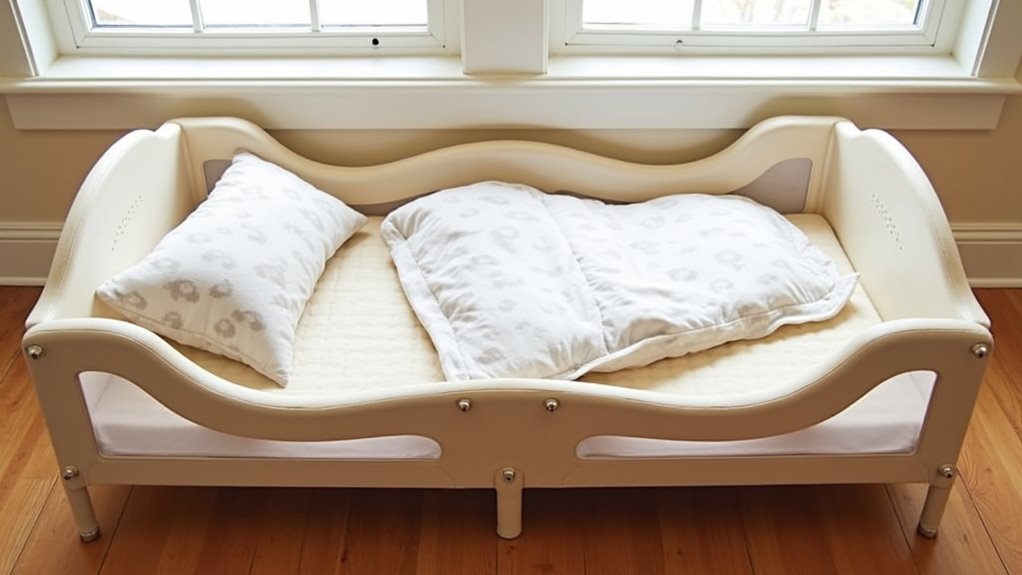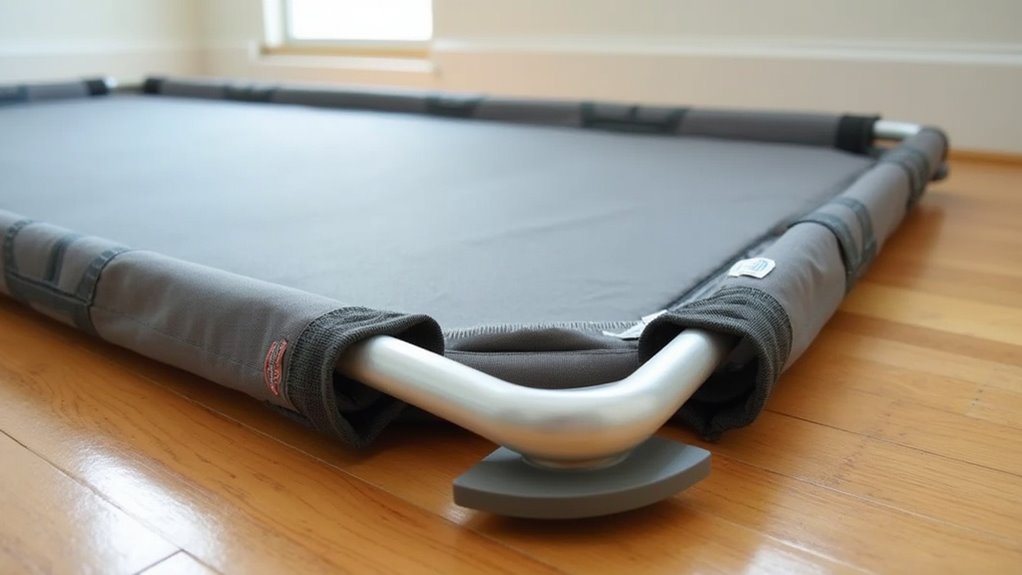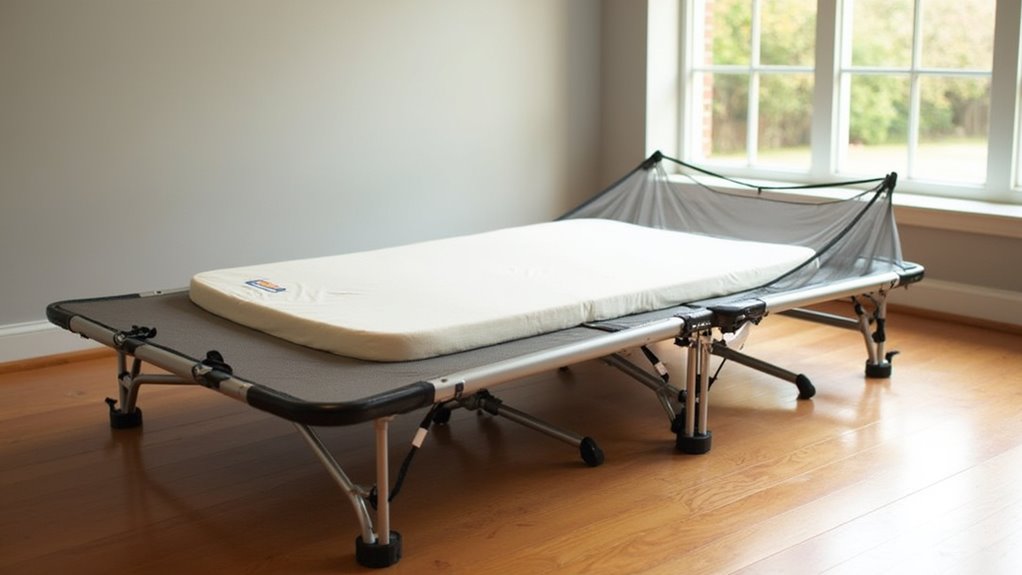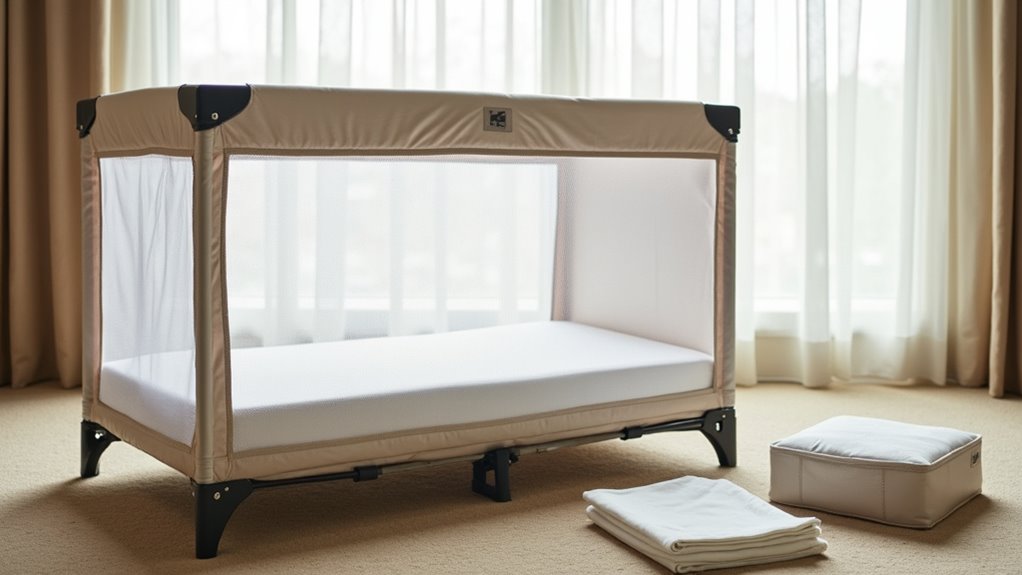Physical Address
304 North Cardinal St.
Dorchester Center, MA 02124
Physical Address
304 North Cardinal St.
Dorchester Center, MA 02124

Tired of sleepless family trips? Discover the best portable beds that will help your little ones rest soundly anywhere.
When you’re planning family trips, you will want to quickly discover that your child’s sleep setup can make or break the entire experience. Whether you’re visiting relatives, staying at hotels, or camping under the stars, a reliable travel bed guarantees your little one gets proper rest away from home. You don’t need to spend a fortune, but you should focus on key features that balance safety, comfort, and convenience. Let’s explore how to choose the right solution for your family’s specific needs.

When choosing a travel bed for your child, understanding essential safety standards isn’t just about compliance—it’s about protecting your little one from preventable hazards.
Look for products that meet CPSC’s mandatory standards and the new federal regulation (16 CFR Part 1270), which took effect in August 2023.
Your travel bed must have smooth surfaces without sharp edges, secure joints, and proper entrapment protection. Manufacturers must provide specific guidance about mattress thickness ranges to ensure safe use.
Check that all materials are non-toxic and that mesh sides allow proper airflow.
Pay close attention to the mattress specifications—using the wrong thickness can create dangerous gaps.
The bed should feature robust locking mechanisms and remain stable during use.
Don’t forget to verify weight limits and size restrictions for your child’s age group, ensuring the bed will safely accommodate their movements throughout the night.
Safety standards lay the groundwork for your next important decision: selecting the right size and age-appropriate travel bed.
Choosing the right travel bed starts with safety – it’s the foundation for finding the perfect fit for your little one.
For newborns, opt for compact bassinets that provide a snug, cozy environment. As your baby grows, consider portable cribs that measure 28 by 52 inches – the standard size that’ll work through the toddler years.
When choosing between models, consider your child’s growth. While mini cribs are slightly smaller, they mightn’t last as long.
For toddlers who’ve outgrown their portable cribs, look into specialized travel beds that prevent climbing. If you’re frequently flying, consider award-winning options like Flyaway Kids Beds that serve both as sleep and play spaces. These innovative solutions can be quickly set up, taking just 90 seconds to inflate and offering instant deflation when needed.
Many convertible models adapt as your child grows, offering better long-term value for your investment.

Five essential comfort features make or break a travel bed’s usability for your little one. Look for a firm-but-cushioned mattress with at least 1-inch padding that fits snugly against the frame to prevent gaps.
You’ll want breathable mesh panels for proper airflow and your peace of mind when monitoring your child. Top options like the Silver Cross Sleep & Go offer a versatile 3-in-1 design that adapts as your child grows.
Choose a model with soft, non-irritating fabrics and guarantee it includes machine-washable covers for easy cleaning.
Consider options that let you use familiar bedding from home, as this helps maintain your child’s sleep routine while traveling.
A sturdy frame without sharp edges provides necessary stability, while designs that mimic home cribs offer emotional security.
If your budget allows, custom-fitted sheets are worth the investment to prevent slipping and guarantee safer sleep.
Portable travel beds must excel in three key areas: easy transport, quick setup, and versatile use across different locations. You’ll find many models that pack into carry-on compliant backpacks or cases, making air travel hassle-free.
Look for beds featuring no-tool assembly that you can set up in under a minute. The best options include clear instructions and intuitive folding mechanisms you’ll master quickly. Many travel beds like the Sleepah model can be fully inflated in under 5 minutes with the included pump.
When choosing a travel bed, prioritize those with built-in carrying solutions like handles or backpack straps. Essential gear for your next camping adventure can be useful to consider when selecting a portable travel bed.
Consider where you’ll use the bed most – whether it’s hotels, camping, or grandparents’ homes. Many models work well on various surfaces and double as playpens.
Don’t forget to check for safety features like non-slip bases and secure locking mechanisms that guarantee stability during both transport and use.

To keep your travel bed in top condition for years of family adventures, proper maintenance makes all the difference.
Clean surfaces daily with warm water and mild detergent using a soft cloth, and address spills immediately to prevent stains. Don’t use harsh chemicals that could damage materials or irritate your child’s skin. Always dry surfaces thoroughly after cleaning to prevent moisture damage.
Check structural components weekly, including rails, latches, and screws. You should aim to verify all moving parts work smoothly and lock securely.
Pay special attention to gaps between the mattress and rails to prevent entrapment risks. Rotate the mattress regularly and use a waterproof protector for extended life.
Maintain a simple cleaning and inspection checklist, and you’ll stay on top of maintenance needs.
Remember to air out bedding periodically and follow manufacturer guidelines for washing materials.
Keeping your travel bed organized and readily accessible can make family trips considerably smoother. Store your child’s travel bed in a waterproof, padded carrying case with clear labels, and include dedicated compartments for bedding essentials.
You’ll need to use vacuum-sealed bags for linens to save space and prevent moisture damage. Consider using a heavy mat underneath storage containers to prevent sliding during transport.
Practice setting up and breaking down the bed before your trip to avoid frustration later. Keep all components, including pumps or connectors, in one designated spot, and create a simple checklist of bedtime items.
Pack sleep essentials like blankets and pillows in coordinated storage pouches for easy access. Don’t overpack the storage bags – this’ll make transport difficult and could damage the bed.
Regular inspection of both the bed and storage containers will make certain everything stays safe and functional.
Your child’s travel bed is like a portable nest, offering both safety and comfort wherever your adventures take you. When you invest in the right model, following proper safety standards and age recommendations, you’ll guarantee peaceful rest for your little one. Remember, regular maintenance and smart storage practices will protect your investment, making family trips more enjoyable without breaking the bank, regardless of your destination or cultural traditions.